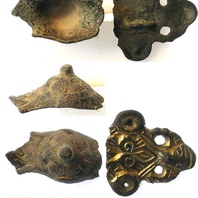
Viking Objects
Fragment of an Equal-Armed Brooch (SWYOR-FAFC04)
A fragment of a Viking Age equal-armed brooch found at Harworth Bircotes, Nottinghamshire. This fragment is the boss of the brooch and resembles brooches found at Birka, Sweden. Its decoration consists of a Borre style animal with gripping arms or legs. This is one of only six Scandinavian, Viking period equal-armed brooches recorded in England. For more information on Scandinavian jewellery in England check out our blog: Brooches, Pendants and Pins: Scandinavian Dress Accessories in England.
Read More

Viking Talks
Danelaw Saga
Invade … immigrate … integrate … inspire. The exhibition ‘Danelaw Saga’ ran from 15th December 2017 to 8th April 2018 and told the tale of how the Vikings shaped the East Midlands. In the 860s the Great Heathen Army invaded the East Midlands, agreeing peace with the Anglo-Saxon King, Alfred the Great, in the 870s. The agreement established the Danelaw where Viking laws and government reigned, giving the Vikings half of England to rule. They settled in the five boroughs of the Danelaw (Derby, Leicester, Lincoln, Nottingham and Stamford) and integrated with the existing population. The legacy of these settlers can still be seen today in place-names like Gunthorpe, Nottinghamshire, named after Gunnhild, a woman with a Viking name. This film about the exhibition ‘Danelaw Saga’ tells a local story of Viking culture with artefacts, maps and medieval documents from Manuscripts and Special Collections at the University of Nottingham and from regional museums. The exhibition presented an opportunity to see extraordinary Viking works brought together and to learn about the places whose names evoke the Viking past. Visitors could map the routes of Viking expeditions, view coins brought from the Middle East to the East Midlands, and explore their heritage further through artefacts and jewellery worn by the Viking women that settled in the East Midlands. ‘Danelaw Saga’ tells the story of Viking heritage hidden in plain sight, from place names in use since they were given by the Vikings to modern literature inspired by the East Midlands’ own Viking past. ‘Danelaw Saga’ uncovers the legacy of the Vikings on our doorstep.
Read More
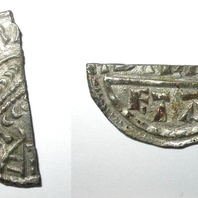
Viking Objects
Coin of Burghred of Mercia (1989-58/3723)
A silver penny of Burghred of Mercia, found in the mass grave at Repton, minted by the moneyer Dudda, probably in London. Burghred was king of Mercia from 852-874 CE. He was driven out of Mercia by the Vikings during their march from Lindsey to Repton in 874 after they sacked Tamworth. Burghred fled to Rome, where he eventually died, and was replaced by Ceowulf II who was loyal to the Vikings. Minting coins was a way of controlling the means of exchange within a kingdom and which created a more easily administered standardized system of trade. Moreover, the coins themselves were often used as propaganda, portaying symbols and statements that gave off a desired message. The Vikings later used the minting of coins to legitimize their own rule.
Read More
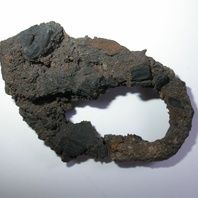
Viking Objects
Iron Buckle (1985/225-3)
An iron buckle from Mound 1 at Heath Wood, Ingleby. The pin of the buckle is bent to one side. This was part of a grave assemblage that include fragments of a sword and other belt fittings.
Read More
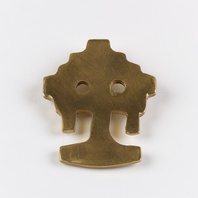
Viking Objects
Reproduction Jewellery Die Stamp
A copper alloy die for creating pressed silver or gold pendants. The original on which this is based had traces of interlace decoration. The presence of finds like this suggests that high-status jewellery production took place in the northern Danelaw.
Read More
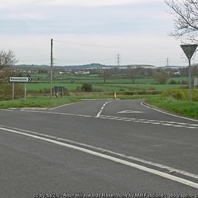
Viking Names
Ravenstone
Ravenstone, in the West Goscote Hundred of Leicestershire, is a hybrid name from the common Old Norse male personal name Hrafn combined with Old English tun ‘farm, settlement’. It has been suggested that the first element might be the Old English male personal name Hræfn, but it is unlikely. Ravenstone was originally part of the Repton and Gresley Hundred in Derbyshire and was transferred to Leicestershire in 1884 as a joint parish with Snibstone.
Read More

Viking Names
Swithland
Swithland, in the West Goscote Hundred of Leicestershire, comes from Old Norse sviðinn ‘land cleared by burning’ and Old Norse lundr ‘a small wood’. Thus the place-name has the meaning of ‘the wood next to or containing land cleared by burning’.
Read More

Viking Talks
Repton and the Legacy of the Viking Great Army
In 873 the Viking Great Army attacked the monastery in Repton, forcing the Mercian king to flee the country and installing a puppet king in his place. 1100 years later, excavations uncovered a large defensive ditch, several distinctly Scandinavian graves, and a mound containing the remains of nearly 300 people. This talk presents new scientific analyses of the burials at Repton, bringing us closer to uncovering the identities of those buried there. In addition, results of new excavations have provided a better understanding of the Viking winter camp. Put together, this new evidence allows for a reassessment of the Viking presence in Repton and the legacy the Great Army left behind. Cat Jarman Wednesday 28 February 2018
Read More
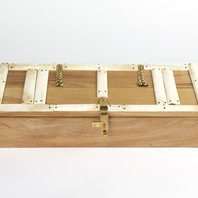
Viking Objects
Reproduction Wooden Box
A reproduction wooden box based on examples from Lincoln, York and Norway. The box is decorated with bone strips carved with a circular dot design. Boxes like this would have been fastened with padlocks
Read More
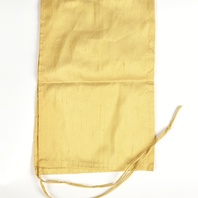
Viking Objects
Reproduction Silk Headdress
A yellow silk headdress based on examples found in Lincoln, York and Dublin. The silk would have been imported from the Eastern Mediterranean.
Read More
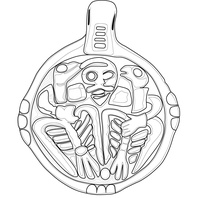
Viking Designs
Drawing of the Winteringham Pendant
A drawing of a cast silver, gilded pendant which has been interpreted as representing an image of Odin and his two ravens Huginn and Muninn. There are a number of close parallels which establish the wide currency of this subject group. These include numerous examples from Russia and two from Sweden, including some with silver gilding. A silver pendant with a related, but distinct design is known from Sjælland, Denmark. With some exceptions, pendants were generally worn by women as part of their Scandinavian dress.
